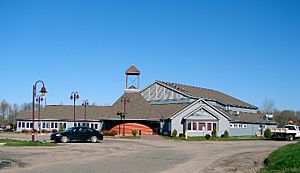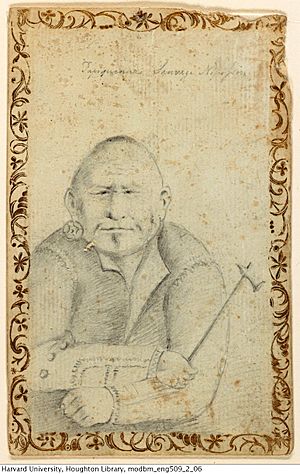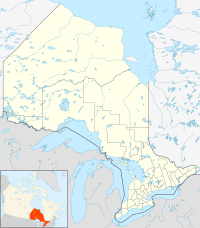Nipissing First Nation facts for kids
Quick facts for kids
Nipissing 10
|
|
|---|---|
| Nipissing First Nation | |

Administration Building/Community Centre in Garden Village
|
|
| Country | Canada |
| Province | Ontario |
| District | Nipissing |
| First Nation | Nipissing |
| Area | |
| • Land | 61.22 km2 (23.64 sq mi) |
| Population
(2011)
|
|
| • Total | 1,450 |
| • Density | 23.7/km2 (61/sq mi) |
| Website | www.nfn.ca |
The Nipissing First Nation is a community of Indigenous people called Nishnaabeg. Their name, Nipissing, means "place of little waters". They have lived for a long time along the shores of Lake Nipissing in northern Ontario. The Nipissing people traditionally speak a language called Anishinaabemwin. In old European records, they were known by many different names.
The Nipissing people are part of the larger Anishinaabe group. They have roots in both the Ojibwe and Algonquin nations. Their homeland is in a special spot where different territories meet. This area is between the lands of the Ojibwe near the Great Lakes and the Algonquin country around the Ottawa River.
Contents
Nipissing Geography and Trade Routes
Lake Nipissing flows into Georgian Bay through the French River. To the east, Trout Lake flows into the Ottawa River by way of the Mattawa River. Living between these two important river systems made the Nipissing people very important for trade. They traded goods in all directions: east, west, north, and south of Lake Nipissing.
Early French explorers and traders used these routes a lot. They would carry their canoes and goods over land (called a portage) to get from the Saint Lawrence River near Montreal to the Great Lakes.
The Nipissing trade routes reached far and wide. To the west, they traded with their Ojibwe neighbours near Lake Nipigon. To the north, they traded with the Cree people near James Bay. Later, they also traded with the English in that area. Their eastern trade network went all the way to what is now Quebec City. The Huron people, who spoke Iroquoian languages, lived nearby to the south. We know from old pottery found by archaeologists that the Nipissing learned some styles and methods from the Huron.
The Nipissing people mainly got their food by hunting, fishing, and gathering plants. Their large trade network likely helped them get other foods too. They probably traded for corn, beans, and squash. These crops were important foods for many First Nations peoples. The land in the lake valleys was good for growing some plants.
Today, the Nipissing First Nation is located between the city of North Bay and the town of West Nipissing. Most members of the First Nation live on their reserve, called Nipissing Indian Reserve 10.
Nipissing History and Treaties

During the early French colonial period, the Nipissing controlled important trade routes. The French were very interested in buying furs from inland areas to send to Europe. This led to competition for furs. The Iroquois people, who lived south of Lake Ontario, fought against the Huron and Nipissing for control of the fur trade.
By 1647, the Nipissing people moved to the Lake Nipigon area. They continued to use their traditional trade routes, but it was more dangerous. A French missionary named Claude-Jean Allouez visited the Nipissing at Lake Nipigon in 1667. However, by 1671, he reported that the Nipissing had returned to Lake Nipissing. After returning, some Nipissing people moved to missions in Trois-Rivières and Oka, Quebec.
In 1850, the Nipissing signed the Robinson Treaty with representatives of the British Crown (the Canadian government). Many European settlers were moving into the area. The Nipissing wanted to make sure their claim to the north shores of Lake Nipissing and its main waterways was clear.
Nipissing Reserve and Communities
Nipissing 10, as it was once known, is an Indian reserve in northeastern Ontario. It is located on the north shores of Lake Nipissing in the Nipissing District. This reserve is the main land area for the Nipissing First Nation. The reserve covers about 21,007 hectares (51,910 acres). It is located west of North Bay and east of West Nipissing.
The reserve includes several communities. These are Beaucage, Jocko Point, Yellek, Duchesnay, and Garden Village. There are also many smaller neighbourhoods. Garden Village can be reached by streets in Sturgeon Falls. The other communities can all be reached directly from Highway 17 West.
Nipissing Society and Clans
Traditionally, the Nipissing nation was organized around families and clans. These clans are called doodems in the Anishinaabe language. There are five main doodems:
- Blood (Miskwaa'aa)
- Birchbark (Wiigwaas)
- Heron (Ashagi)
- Beaver (Amikwaa)
- Squirrel (Asanagoo)
When Europeans first met the clans, the Blood, Birchbark, and Squirrel clans lived around Lake Nipissing. The Heron clan lived mostly on Lake Nipissing, but also on lands stretching south to Lake Huron's Georgian Bay. The Beaver clan lived on the northern coast of Georgian Bay, next to the Heron territory.
Each clan was divided into family groups. They governed themselves, but also worked together as part of the Nipissing Nation as a whole. They respected each person's right to choose their own path in life.
Nipissing Population Information
As of February 2009, the Nipissing First Nation had a total of 2,201 registered people. Of these, 886 lived on their own reserve. The 2001 Canadian Census recorded that 1,378 people lived on Nipissing 10 Indian Reserve.
According to the 2011 Canadian Census:
- Population: 1,450 people
- Change from 2006-2011: 2.6% increase
- Number of homes (Dwellings): 674
- Area of the reserve: 61.22 square kilometers
- Population density (people per square kilometer): 23.7
Nipissing Governance and Leadership
The Nipissing First Nation is currently led by elected officials. They use their own custom electoral system. The leadership includes a chief, a deputy chief, and six councillors. The current council includes Chief Scott McLeod and Deputy Chief Muriel Sawyer. The councillors are June Commanda, Brian Couchie, Corey Goulais, Jane B Commanda, Michael Sawyer, and Eric "Ric" Stevens. Their three-year term ended on July 31, 2018.
The Nipissing First Nation's council is part of the Waabnoong Bemjiwang Association of First Nations. This is a group of regional chiefs' councils. The First Nation is also a member of the Union of Ontario Indians. This is a political organization that represents many Anishinaabe First Nations in central and southern Ontario.
In January 2014, the Nipissing First Nation adopted what is believed to be the first constitution for First Nations in Ontario. This constitution is meant to replace the Indian Act as the main law for governing the First Nation. However, it has not yet been tested in court.
Notable Nipissing People
- Dan Frawley (ice hockey) (born 1962): An NHL hockey player who was captain of the Pittsburgh Penguins in 1987.
- Ian Campeau: A member of the music group A Tribe Called Red.



